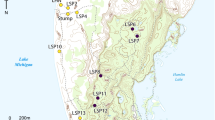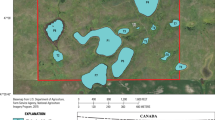Abstract
Habitat heterogeneity and wetland area play important roles in aquatic biodiversity; however, other factors are equally important in the composition and distribution of ecological communities. Over a 3-year period, including a year of drought, we demonstrate how beavers physically altered isolated shallow-water wetlands in Miquelon Lake Provincial Park, Canada, which then influenced aquatic invertebrates diversity and abundance of functional feeding groups and taxa. Digging channels by beavers extended aquatic habitats over 200 m into the upland zone and created unique aquatic habitats, which became hot-spots for predaceous aquatic invertebrates. Some taxa (e.g., Gerridae and Gyrinidae) were found exclusively in beaver ponds, while Culicidae were primarily in wetlands without beavers. Amphipoda were strongly associated with beaver ponds in drought and post-drought years. During extreme drought in 2009, species richness, diversity and abundance declined dramatically, but recovered quickly in 2010. Although species richness was associated with wetland area, increased niche availability through active maintenance of wetlands by beavers played an important role in aquatic invertebrate diversity and distribution. Understanding the role of common, but seldom surveyed within-wetland habitats in boreal wetlands expands our ability to understand aquatic biodiversity, the importance of habitat heterogeneity and the role of other taxa in species assemblages.


Similar content being viewed by others
References
Achuff PL (1994) Natural regions, subregions and natural history themes of Alberta: a classification for protected areas management (updated and revised version). Prepared for Parks Services. Alberta Environment, Edmonton, 72 pp
Alsfeld AJ, Bowman JL, Deller-Jacobs A (2009) Effects of woody debris, microtopography, and organic matter amendments on the biotic community of constructed depressional wetlands. Biological Conservation 142:247–255
Angradi TR, Jicha TM (2010) Mesohabitat-specific macroinvertebrate assemblage responses to water quality variation in mid-continent (North America) great rivers. Ecological Indicators 10:943–954
Batzer DP, Wissinger SA (1996) Ecology of insect communities in nontidal wetlands. Annual Review of Entomology 41:75–100
Batzer DP, Palik BJ, Buech R (2004) Relationships between environmental characteristics and macroinvertebrate communities in seasonal woodland ponds of Minnesota. Journal of the North American Benthological Society 23(1):50–68
Bayrock LA, Hughes GM (1962) Surficial geology of the Edmonton District, Alberta. Earth Sciences Report 1962–06. Alberta Geological Survey, Edmonton
Bazzanti M, Coccia C, Dowgiallo MG (2010) Microdistribution of macroinvertebrates in a temporary pond of Central Italy: taxonomic and functional analyses. Limnologica 40(1):291–299
Braccia A, Batzer DP (2001) Invertebrates associated with woody debris in a Southeastern U.S. forested floodplain wetland. Wetlands 21(1):18–31
Bromley CK, Hood GA (2013) Beavers (Castor canadensis) facilitate early access by Canada geese (Branta canadensis) to nesting habitat and areas of open water in Canada’s boreal wetlands. Mammalian Biology 78:73–77
Butts WL (2001) Beaver ponds in upstate New York as a source of anthropophilic mosquitoes. Journal of the American Mosquito Control Association 17:85–86
Butts WL (2004) Changes in distribution and abundance of mosquito populations in an ecological research tract over a 35 year history. Journal of the American Mosquito Control Association 20:319–320
Christensen JR, Crumpton WG (2010) Wetland invertebrate community responses to varying emergent litter in a prairie pothole emergent marsh. Wetlands 30(6):1031–1043
Clarke KR (1993) Non-parametric multivariate analyses of changes in community structure. Australian Journal of Ecology 18:117–143
Clifford HF (1991) Aquatic invertebrates of Alberta. University of Alberta Press, Edmonton, 538 pp
Clifford HF, Wiley GM, Casey RJ (1993) Macroinvertebrates of a beaver-altered boreal stream in Alberta, Canada, with special reference to the fauna of dams. Canadian Journal of Zoology 71:1439–1447
Collen P, Gibson RJ (2001) The general ecology of beavers (Castor spp.) as related to their influence on stream ecosystems and riparian habitats and the subsequent effects on fish—a review. Reviews in Fish Biology and Fisheries 75:1009–1013
Cummins KW (1973) Trophic relations of aquatic insects. Annual Review of Entomology 18:183–206
de Szalay FA, Cassidy W (2001) Effects of muskrat (Ondatra zibethicus) lodge construction on invertebrate communities in a Great Lakes coastal wetland. American Midland Naturalist 146(2):300–310
de Szalay FA, Resh VH (1996) Spatial and temporal variability of trophic relationships among aquatic macroinvertebrates in a seasonal marsh. Wetlands 16(4):458–466
ESRI (2006) Environmental Research Institute, Inc., Redlands, CA, USA
France RL (1997) The importance of beaver lodges in structuring littoral communities in boreal headwater lakes. Canadian Journal of Zoology 75:1009–1013
Gathman JP, Burton TM (2011) A Great Lakes coastal wetland invertebrate community gradient: relative influence of flooding regime and vegetation zonation. Wetlands 31:329–341
Hann BJ (1995) Nektonic macroinvertebrates in a wetland pond (Crescent Pond, Delta Marsh, Manitoba). UFS (Delta Marsh) Annual Report 30:68–77
Hawkins CP, Sedell JR (1981) Longitudinal and seasonal changes in functional organization of macroinvertebrate communities in four Oregon streams. Ecology 62(2):387–397
Heino J (2000) Lentic macroinvertebrate assemblage structure along gradients in spatial heterogeneity, habitat size and water chemistry. Hydrobiologia 418(1):229–242
Hood GA, Bayley SE (2008) Beaver (Castor canadensis) mitigate the effects of climate on the area of open water in boreal wetlands in western Canada. Biological Conservation 141:556–567
Hood GA, Bayley SE (2009) A comparison of riparian plant community response to herbivory by beaver (Castor canadensis) and ungulates in Canada’s boreal mixed-wood forest. Forest Ecology and Management 258:1979–1989
Hornung JP, Foote AL (2006) Aquatic invertebrate responses to fish presence and vegetation complexity in western boreal wetlands, with implications for waterbird productivity. Wetlands 26(1):1–12
Hutchinson GE (1957) Concluding remarks. Cold Spring Harbor Symposium on Quantitative Biology 22:415–427
IBM, SPSS Software (2010) IBM SPSS statistics version 19. Armonk, New York
Jeffries M (1994) Invertebrate communities and turnover in wetland ponds affected by drought. Freshwater Biology 32:603–612
Jeffries M (2011) The temporal dynamics of temporary pond macroinvertebrate communities over a 10-year period. Hydrobiologia 661(1):391–405
Jones CG, Lawton JH, Shachak M (1994) Organisms as ecosystem engineers. Oikos 69:373–386
Kadman R, Allouche O (2007) Integrating the effects of area, isolation, and habitat heterogeneity on species diversity: a unification of island biogeography and niches theories. American Midland Naturalist 170(3):443–454
Kratzer EB, Batzer DP (2007) Spatial and temporal variation in aquatic macroinvertebrates in the Okefenokee Swamp, Georgia, USA. Wetlands 27(1):127–140
MacArthur RH, Wilson EO (1963) An equilibrium theory of insular biogeography. Evolution 17:273–387
MacArthur RH, Wilson EO (1967) The theory of island biogeography. Princeton University Press, Princeton
Marglois BE, Raesly RL, Shumway DL (2001) The effects of beaver-created wetlands on the benthic macroinvertebrate assemblages of two Appalachian streams. Wetlands 21(4):554–563
McCune B, Grace JB (2002) Analysis of ecological communities. MjM Software Design, Gleneden Beach
McCune B, Mefford MJ (2011) PC-ORD multivariate analysis of ecological data. Version 6. MjM Software, Glenedon Beach
McDowell DM, Naiman RJ (1986) Structure and function of a benthic invertebrate stream community as influenced by beaver (Castor canadensis). Oecologia 68:481–489
McParland CE, Paszkowski CA (2006) Effects of small-bodied fish on invertebrate prey and foraging patterns of waterbirds in Aspen Parkland wetlands. Limnology and Aquatic Birds 567:43–55
Merritt RW, Cummins KW, Berg MB (eds) (2008) An introduction to aquatic insects of North America, 4th edn. Kendall/Hunt Publishing Company, Dubuque
Meyer CK, Peterson SD, Whiles MR (2011) Quantitative assessment of yield, precision, and cost-effectiveness of three wetland invertebrate sampling techniques. Wetlands 31:101–112
Mitchell PA (1990) Miquelon Lake. In: Mitchell PA, Prepas EE (eds) Atlas of Alberta Lakes. University of Alberta Press, Edmonton
Naiman RJ, McDowell DM, Farr BS (1984) The influence of beaver (Castor canadensis) on the production dynamics of aquatic insects. Verhandlungen der Internationalen Vereinigung für Theoretische und Angewandte Limnologie 22:1801–1810
Navarro-Llácer C, Baeza D, de las Heras J (2010) Assessment of regulated rivers with indices based on macroinvertebrates, fish and riparian forest in the southeast of Spain. Ecological Indicators 10:935–942
Odling-Smee FJ, Laland KN, Feldman MW (1996) Niche construction. American Naturalist 147:641–648
Pielou EC (1966) The measurement of diversity in different types of biological collections. Journal of Theoretical Biology 13:131–144
Pollack MM, Naiman RJ, Hanley TA (1988) Plant species richness in riparian wetlands—a test of biodiversity theory. Ecology 79:94–105
Shannon CE (1948) A mathematical theory of communication. Bell System Technical Journal 27:379–423, And 623–656
Stachowicz JJ (2001) Mutualism, facilitation, and the structure of ecological communities. BioScience 51(3):235–246
StatSoft, Inc. (2003) Statistica version 6. Tulsa, Oklahoma
Thorp JP, Covich AP (2001) Ecology and classification of North American freshwater invertebrates. Academic Press/Harcourt Brace, Inc, San Diego
Turner AM, Trexler JC (1997) Sampling aquatic invertebrates from marshes: evaluating the options. Journal of the North American Benthological Society 16(3):694–709
Uzarski DG, Genet JA (2004) Invertebrate habitat use in relation to fetch and plant zonation in northern Lake Huron coastal wetlands. Aquatic Ecosystem Health and Management 7(2):249–267
Van de Meutter F, De Meester L, Stoks R (2007) Metacommunity structure of pond macro invertebrates: effects of dispersal mode and generation time. Ecology 88(7):1687–1695
Van de Meutter F, Cottenie K, De Meester L (2008) Exploring differences in macroinvertebrate communities from emergent, floating-leaved and submersed vegetation in shallow ponds. Fundamental and Applied Limnology 173(1):47–57
Westbrook CJ, Cooper DJ, Baker BW (2006) Beaver dams and overbank floods influence groundwater-surface water interactions of a Rocky Mountain riparian area. Water Resources Research 42, W06406. doi:10.1029/2005WR004560
Wright JP, Jones CG (2006) The concept of organisms as ecosystem engineers ten years on: progress, limitations, and challenges. BioScience 56:203–209
Acknowledgments
We are grateful for financial assistance from the Beaver Hills Initiative, Alberta Sport, Recreation, Parks and Wildlife Foundation, the Augustana Faculty of the University of Alberta, Alberta Tourism Parks and Recreation, and Dr. Suzanne Bayley. In addition, we are thankful for the field and lab assistance of Dr. Heather Proctor, Nils Anderson, Nicole Madu, Tim Nelner, Curtis Stratmoen, Stephen Olson, Makrina Scott, and Dustin Rahib and the statistical advice of Drs. Rebecca Rooney and David Locky. Finally, we thank Dee Patriquin and the anonymous reviewers, and the Associate Editor whose comments and advice helped to make this a stronger manuscript.
Author information
Authors and Affiliations
Corresponding author
Electronic supplementary material
Below is the link to the electronic supplementary material.
Table S1
(DOC 129 kb)
Table S2
(DOC 44 kb)
Table S3
(DOC 52 kb)
Supplementary Figure S1
(JPEG 115 kb)
Rights and permissions
About this article
Cite this article
Hood, G.A., Larson, D.G. Beaver-Created Habitat Heterogeneity Influences Aquatic Invertebrate Assemblages in Boreal Canada. Wetlands 34, 19–29 (2014). https://doi.org/10.1007/s13157-013-0476-z
Received:
Accepted:
Published:
Issue Date:
DOI: https://doi.org/10.1007/s13157-013-0476-z




